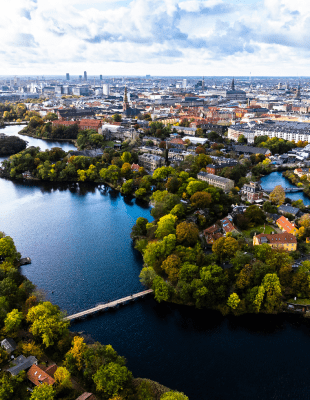The 2023 Global Risks Report highlights more than ever the inter-connected nature of the various crises our world faces – we decided to think about it through a water lens. Water is mentioned 90 times in the report however is not visible as a core foundation connecting many of these crises (food, cost of living, biodiversity, climate, etc). In the year where the World Economic Forum declared a polycrisis, we want to showcase the easy wins for combining water and nature goals/targets/actions at the UN Water Conference. This blog provides a platform for Arcadis’ sustainability vision as well as elevating some case studies that emphasize Arcadis’ capability of working on this. Arcadian Global Experts on water and nature (Tugba and Daisy respectively) share their examples of where we can find poly-solutions to a polycrisis.
The World Economic Forum (WEF) recently introduced a new term to the stage – polycrisis1 – which appropriately sums up the complex situation we currently face in our world. Evidence of a building polycrisis, made up of interconnected crises including climate change, socio-economic fall-out, biodiversity loss, ecosystems collapse and shortages in resources, can be found across news outlets.
And all of these risks? They have direct links to water and nature. Could water-nature “poly-solutions” be the answer? Arcadians Tugba Cangel Ergin and Daisy Hessenberger use their joint expertise to highlight leverage points where solutions can provide a win-win for water, nature, and people.

Please click here to see full image.
The polycrisis, where we face multiple crises at the same time, is the prevailing narrative in the World Economic Forum’s 2023 Global Risk Report.1 The risks that make up this polycrisis are not static, with the report pointing out that the “cost of living dominates global risks in the next two years while climate action failure dominates the next decade”. In a world standing on the precipice of this polycrisis, we can profit both in the short and long term from comprehensive “poly-solutions” that concurrently address multiple challenges.
Water provides a prime entry point for “poly-solutions” to resolve our “polycrisis”. Our water needs are already intrinsically linked to social, technological, engineering and natural approaches and water-based solutions can help address many of the risks identified in the WEF’s report. However, in the flurry of investment, competition and good intentions, also comes risk of taking actions that, instead of solving our problems, further exacerbate them (examples in options 1-3 in table). Solutions to water challenges cannot come at the cost of nature (Option 2 in table), solutions to the nature crisis cannot come at the cost of water needs (Option 3 in table) and addressing the climate crisis will not be possible if it comes at the cost of either water and/or nature.

No solution. Business as usual where we unsustainably use water and natural resources.
You may use a non-native landscape palette in arid and semi-arid regions where the irrigation demand is extremely high, and the natural soil requires significant changes (fertilizer). This can ultimately cause more water use for irrigation and contaminate the land and water downstream of the surface runoff with highly fertilized soil, negatively impacting ecosystems.

A solution for a water challenge that negatively impacts natural resources.
To maximise downstream water quantity, you may want to remove vegetation – all of it, including the trees. You may also over exploit groundwater resources or divert riverbeds. This can lead to the collapse of ecosystems and indirect impacts through loss of connectivity and carbon sinks.

A solution for a nature challenge that negatively impacts the water resources.
To restore a forest, perhaps also aiming to draw down carbon, you may want to plant trees and other vegetation. Using the incorrect species may result in water shortages as some species may draw up too much water for the ecosystem or require more irrigation water demand.

Sustainable use. A solution that supports underlying natural and water resources.
In order to increase water quality and quantity for a filtration/treatment plant, you could restore/conserve upstream vegetation such as reedbeds (which can act as flood mitigation ponds). This can maximize efficient of surface runoff collection and treatment while also minimizing maintenance costs.
Fortunately, nature and water naturally work well together in a regenerative manner. Solutions can be designed to support this positive feedback loop (Option 4 in the table). Connecting with this circular relationship will be the foundation of the water stewardship of the future. The benefits of restoring this relationship are tangible. For example, working with natural topography can minimise piping and pumping; utilising native species for natural treatment can minimise conventional treatment plants’ footprints; and using rain gardens, bioswales, bio trenches, and natural pools can replace/minimise the stormwater drainage networks. Accordingly, water working together with nature ultimately minimises the CAPEX, OPEX, construction period and carbon impact while maximising the systems’ efficiencies and positive environmental impact. Meanwhile, application of Nature-based Solutions towards nature and water positive projects will not only help resolve the polycrisis but will also reduce the time needed for any other conventional mega-scale infrastructure applications (including legislation changes, approvals, funding, and construction period). In short, moving away from working exclusively in or against the nature, the new decade’s business as usual should offer solutions working with nature.
Clearly, we want to implement the fourth option benefiting both water and nature (and climate), something that cannot be done overnight. Developing integrated nature and water solutions will require more than restoring isolated parcels of bit of wetland, or improving localised remediation efforts. It is about game-changing, large-scale landscape appreciation to create solutions using all the approaches we have available, whether they be grey, blue, green, technological, social, cultural or a hybrid of them all. Currently not many solutions are designed to create this positive feedback loop, providing a bleak outlook for our ability to address this polycrisis. A first step however is focusing on enabling approaches/technology/solutions that bring us closer to that truly circular future. By no means exhaustive, here are examples of how sustainable methodologies play out in solutions:
- Natural infrastructure management for water quality/flow – Transforming the Rio Tiete – Investing to Improve Water Quality: Pollution caused by population growth and industrialization banned trade and leisure activities at the river. In the 1990's the state embarked on an ambitious river clean-up project. Infrastructure provided a solution to both safely treat the sewage generated by 19 million inhabitants and significantly improve the health and quality of the river.
- Sustainable water management in agriculture - VLOED: Improving agricultural land by raising the ground level with sludge from the Ems-Dollard: The natural state of the Ems-Dollard is rapidly deteriorating due to sedimentation, which causes turbid water and biodiversity loss. Arcadis investigated whether it could improve Ems-Dollard’s water quality by applying the dredged material on land.
- Nature masterplans with water - A Green Masterplan: Greenport Venlo: Arcadis supported the clients to realize their spatial-economic ambitions, more than 2,000 ha of area will be transformed into a working landscape, infrastructure, and nature. The Arcadis team was involved in the area’s thematic translation into a water plan, energy plan, nature plan, mobility plan and issuance conditions.
For us to engage these solutions that sew together different approaches, the true value of water and its relationship to nature must be realised. While the Global Risk Report does not explicitly identify water security as a risk, water-related risks are a major factor in multiple of both the short term and long-term risk (link to above figure). Water is also often missing in the nature narrative. At the UN Convention on Biological Diversity’s COP15 in Montreal last year, the relationship with water was regularly discussed, however, mainly to highlight its absence from decision making chambers on nature and biodiversity issues. This absence is striking given that in order to meet the UN Sustainable Development Goals (SDGs), we need to be addressing water related items four times faster than the current pace, which is not yet practically feasible considering current legislation, funding and other challenges.
The UN Water Conference last week was the first of its kind since 1977 after almost 50 years, a global event providing some hope for sewing together the sustainable narratives for water and nature. We see nature and biodiversity is the main focus for one of the five themes adopted for UNWC, “Water for Climate, Resilience, and Environment”, while nature has an indirect link to the other UNWC themes.2 Some of the innovation and partnerships launched at the UNWC, such as WBCSD’s Freshwater Accountability Accelerator and 50L initiatives and recent launch of Arcadis Sustainable Water Stewardship Vision, will provide stepping stones to the water stewardship of the future that both humanity and nature need.
1. The Global Risks Report 2023 (World Economic Forum)
2. Themes Set for UN 2023 Water Conference (IISD)
CO-AUTHOR






